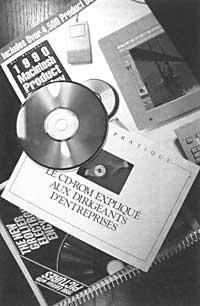CD-ROM: giant warehouse (I)

In the past decade TV manufacturers began working on complementary video to television. Although several mechanical reading video disc systems have appeared, the only system that has reached the present has been the optical video disk. The techniques, engineering and production systems used in the development of this system have served as the basis for the development of other types of products.
Between 1972 and 1976, the search for common regulations provoked strong controversies among manufacturers. After these discussions it was decided to adopt the ALC format (Constant Linear Speed). As a result, PHILIPS and SONY signed a standardization agreement on digital sound discs. Therefore, when the compact music album was first presented at the end of 1983, all the manufacturers and sellers presented a unified (normative) offer.
CD-ROM or Compact disk-read only memory, in Basque we would only say the compact memory disk readable. The idea of the CD-ROM began to be worked in the early years 1.980-1.990, when the compact disc was already maturing. Then someone came up with a version of the compact disk to store the digital data.
Consequently, in 1985 the first databases appeared on the market on CD-ROM.
The wide range of information generated so far by society has been preserved in microfitxeras, magnetic tapes and magnetic discs, among others. While these systems experience significant progress in data collection, storage or transfer, they cannot be considered final.
Laser optical disc based systems have been created as a complementary alternative. In them the information, that is, the text, the image and the sound, is recorded digitally with a laser and recovered with a laser.
Among these systems was created the so-called CD-Audio to listen to Hifi music. Its success lies in the advantages it has against traditional discs, such as sound quality and the absence of wear.
The research and marketing experience of the CD-Audio audio area was applied by PHILIPS and SONY to massive data storage. This is how the CD-ROM system was born.
As all information accumulates digitally, CD-ROM is similar to flexible discs, fixed discs and other magnetic media.



However, the advantages focus on three areas:
- high accumulation power, physically low
- sustainability and portability
- low cost per bit of accumulated information.
As an example, we will mention some advantages and drawbacks compared to some conventional systems.
About microfitxategi
Advantages: digital data are, in principle, very appropriate for its management; the medium is sustainable and the quality of the images is better.Disadvantages: the methods and devices for the production of microchips are already well known and the unit size of the files is more flexible.For printed copies
Advantages: lower accumulation volume, ease of handling, lower risk of file involvement and lower publication costs.Disadvantages: the transformation costs of documents or files are higher and their processing requires the use of a microcomputer.- Advantages over magnetic disks: higher accumulation capacity, longer service life, lower risk of damage and more suitable for storing and handling images.Disadvantages: only data can be read; there are fewer CD-ROM reading units; standard regulations have not yet been reached and software has not reached maturity.
Regarding the accumulation and access of large computers
Pros: Long-term accumulation costs can be lower, user can easily access and control and connection costs.Cons: data update is slower and difficult.
The most important feature of optical discs is their storage capacity, which means a capacity of almost 600 MB. To better understand the capacity of this memori size, it should be noted that 150,000 printed pages or 15,000 commercial documents or 1,200 malignant discs (5,25 fingers) may contain content or that the 8-hour narrative may enter with their images.
But what is the market situation of the CD-ROM?
This technique, created in 1985, had sold in the US in 1.987 60,000 reading units. In the same year only 6,700 were sold in Europe. Of them 4,000 in Italy, 700 in Germany, 400 in Britain, 400 in France, about 200 in Norway and Sweden and some singles in Euskal Herria and Spain. In 1988 these figures multiplied by four in Europe and by 1992 500,000 US readers are expected to launch.

The topics covered are medicine, engineering, law, encyclopedias and banks of images and photographs. The trend of use is similar to that of a large database that will not change much, that is, economic information, the stock exchange, monetary change, etc. will have little chance of working on the CD-ROM, as they are based on information that changes a lot (day to day). Therefore, fixed and non-changing information in the short term is the most suitable for working on CD-ROM.
The selling price is also a factor to consider. At the end of 1986, 370,000 pesetas. a reading unit and 200,000 sts. at the end of 1988. environment. Currently 150,000 sts. and the price goes down. Price developments are related to selling and, of course, the more it is sold, the cheaper it will be. It would not be surprising that the price was rapidly reduced below 100,000 ptas.
In Euskal Herria so far a hundred have been sold.
As for applications, growth has been exponential. At the moment there are thousands of applications in the market, but most are of origin USA or Great Britain. Unfortunately, we do not believe that there is an application in Basque, but Elhuyar has at least intentions of joining this new field.
So far we have made a description of this new technique. In the next issue, we will access the core of the system and explore the physical-technological aspect.





